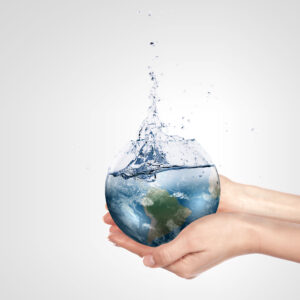World Water Savings Day
March 22nd World Water Day was established in 1993 dedicated to drawing attention to water-related issues. We are highlighting the importance of water conservation in the semiconductor industry: “water is one of the most precious life-giving resources on our planet. Limited availability of clean water continues to be one of our greatest global challenges. Water is an important resource for semiconductor manufacturing. The semiconductor industry is one of the largest consumers of the resource, and a single facility can use over 2 million gallons of Ultra-Pure Water (UPW) a day. Water conservation has been a part of the industry’s focal point to minimize environmental impact from a global standpoint as well as within the community where a facility operates [1].”
 Facing more stringent laws and raised environmental awareness alongside the growing market and need for technological innovation, the semiconductor industry focuses more and more on water conservation. In areas where top manufacturers are located, they may experience challenges in supplying large amounts of water to the facility. Taiwan is home to one of the world’s largest semiconductor manufacturers; they have recently experienced a drought that has now placed a large focus on water conservation. With a growing need for sustainability in water conservation many manufacturers have placed a large focus in this area over the past decade: “for example, Intel, the US-based leading semiconductor chip manufacturer, set its corporate environmental goals including reduction of water use on a per wafer basis below 2010 levels by 2020. In Intel’s 2015 CSR report, the corporate used 34.1 million m3 (Mm3) of freshwater, another 3 Mm3 of gray water from communities. The estimated amount of water conserved in 2015 was about 15.5 Mm3. South Korea-based Samsung used 92.4 Mm3 of water, including 1.23 Mm3 recycled water in 2015, equivalent to a water “value” of 53 m3/million KRW (equivalent to about 0.06 m3/USD). There was a significant fluctuation in these values over the past three years (12.3 Mm3 in 2013 and 0.96 Mm3 in 2014). Taiwan-based TSMC also committed to reducing water use per chip wafer basis to 30% below 2010 levels by 2020. The goal is ambitious due in part to the increased risk of water deficit in Taiwan [2].”
Facing more stringent laws and raised environmental awareness alongside the growing market and need for technological innovation, the semiconductor industry focuses more and more on water conservation. In areas where top manufacturers are located, they may experience challenges in supplying large amounts of water to the facility. Taiwan is home to one of the world’s largest semiconductor manufacturers; they have recently experienced a drought that has now placed a large focus on water conservation. With a growing need for sustainability in water conservation many manufacturers have placed a large focus in this area over the past decade: “for example, Intel, the US-based leading semiconductor chip manufacturer, set its corporate environmental goals including reduction of water use on a per wafer basis below 2010 levels by 2020. In Intel’s 2015 CSR report, the corporate used 34.1 million m3 (Mm3) of freshwater, another 3 Mm3 of gray water from communities. The estimated amount of water conserved in 2015 was about 15.5 Mm3. South Korea-based Samsung used 92.4 Mm3 of water, including 1.23 Mm3 recycled water in 2015, equivalent to a water “value” of 53 m3/million KRW (equivalent to about 0.06 m3/USD). There was a significant fluctuation in these values over the past three years (12.3 Mm3 in 2013 and 0.96 Mm3 in 2014). Taiwan-based TSMC also committed to reducing water use per chip wafer basis to 30% below 2010 levels by 2020. The goal is ambitious due in part to the increased risk of water deficit in Taiwan [2].”
Viewing how important water conservation is here at Trebor we strived to design a system that would best accompany the need to conserve one of the most important resources on our planet. With a high focus on waste eliminating technology, outstanding reliability, and pure innovation. We introduced the Quantum NXT (QNXT) as an eco-innovative water heater focusing on water and cost savings. The ideal system for heating UPW, featuring our patented thin-film quartz electric resistive technology, the QNXT has the lowest cost of ownership in the industry. The QNXT is the predecessor to Trebor’s Quantum originally introduced in 2002. The potential water savings and the full benefits of our QNXT are elaborated in our paper on the Water Conservation of the QNXT system.
Citations
[1] DJ Roy, “Quantum NXT – Water Conservation” 2020. [Online]. Available: https://treborintl.com/2020/08/04/quantum-nxt-water-conservation/
[2] Walter Den, Chih-Hao Chen, Yung-Chien Luo, “Revisiting the water-use efficiency performance for microelectronics manufacturing facilities: Using Taiwan’s Science Parks as a case study,” Water-Energy Nexus, Volume 1, Issue 2, Pages 116-133, 2018. [Online]. Available: https://www.sciencedirect.com/science/article/pii/S2588912518300316


